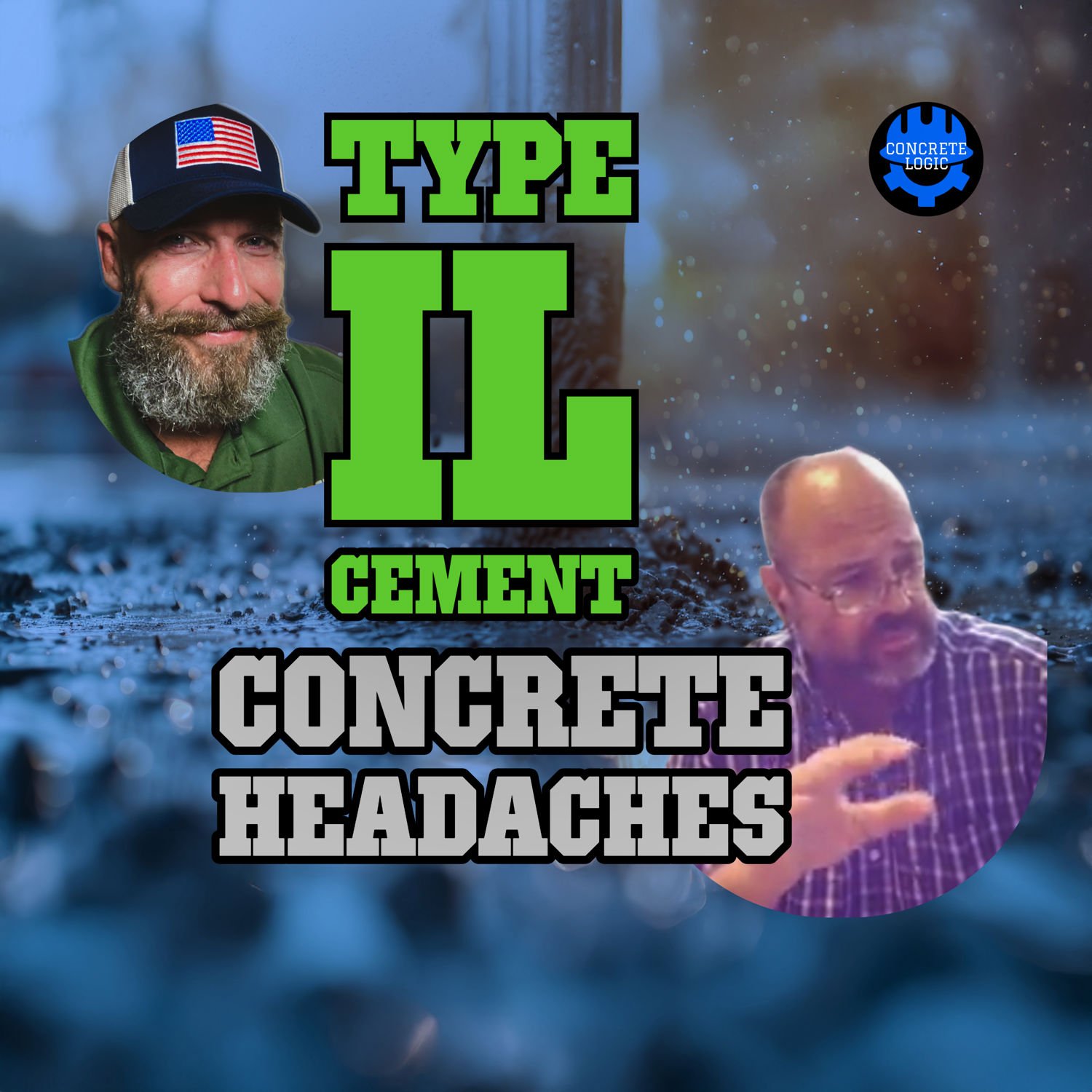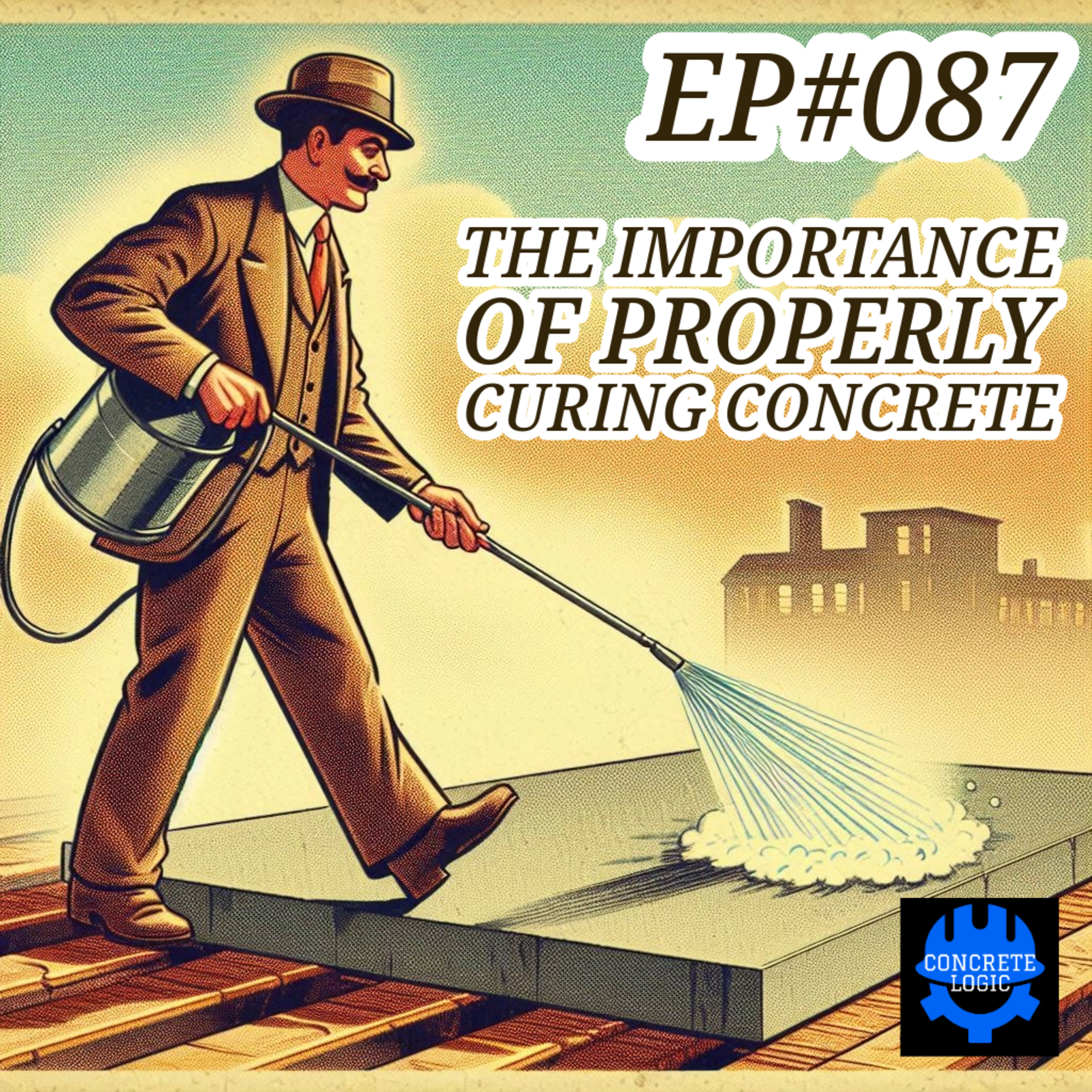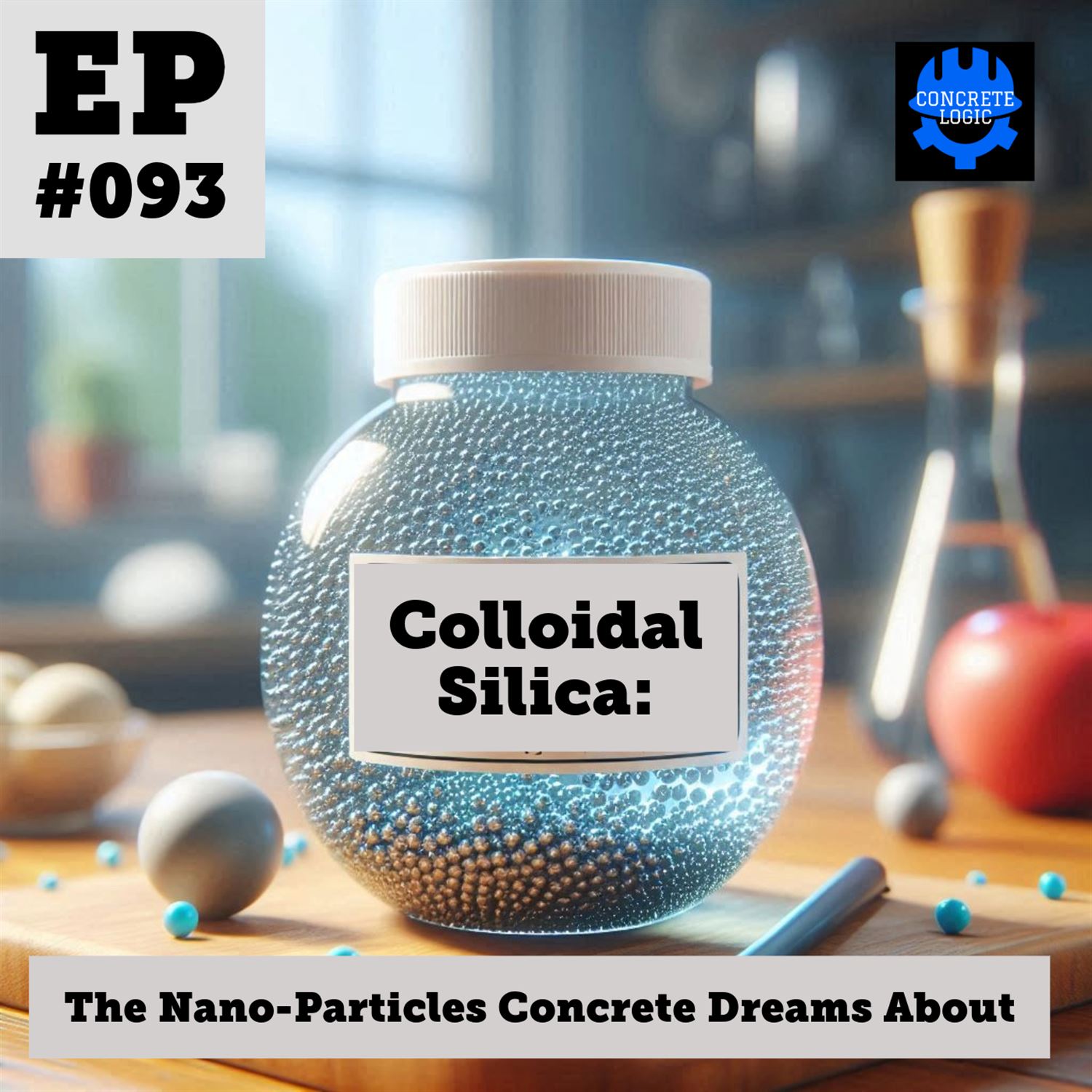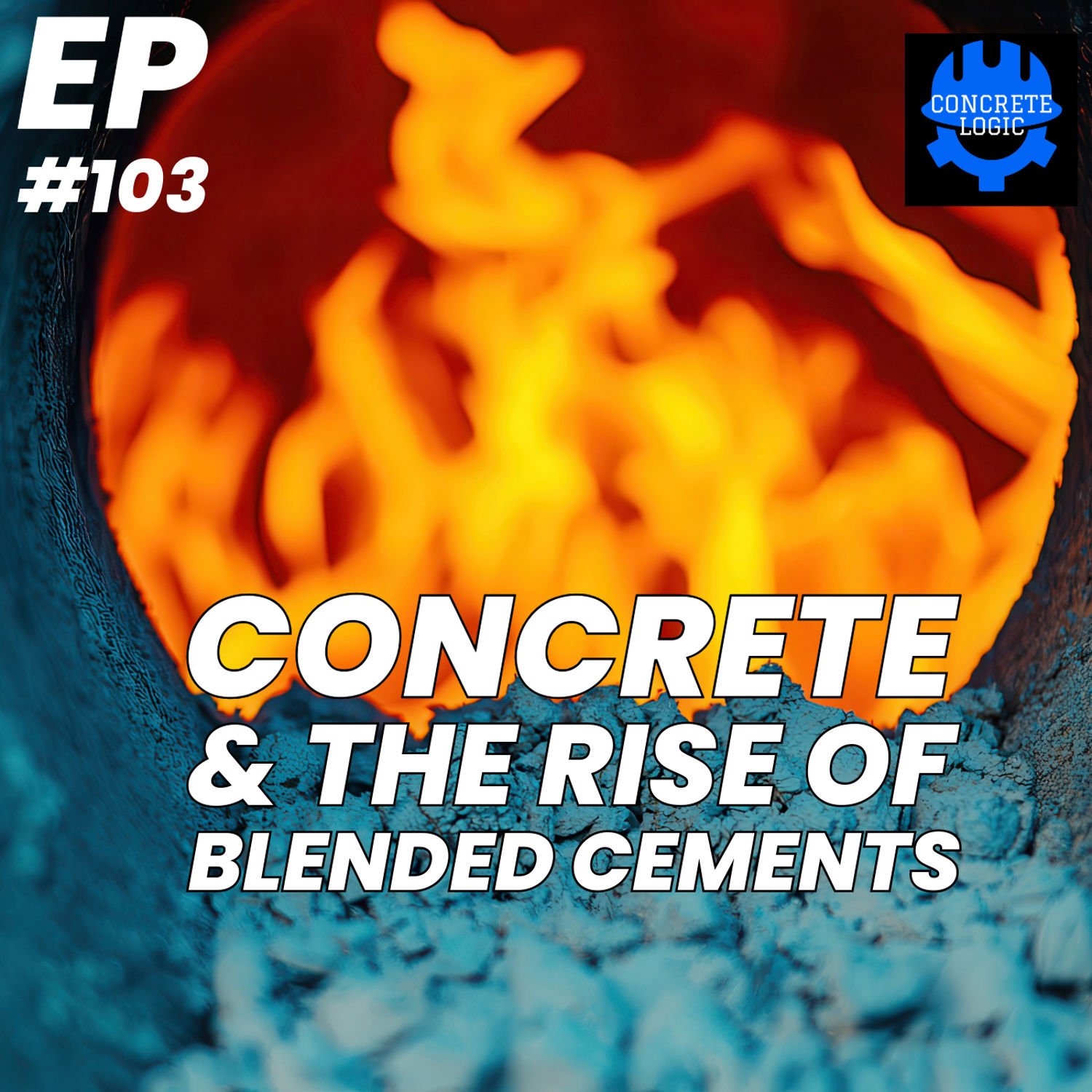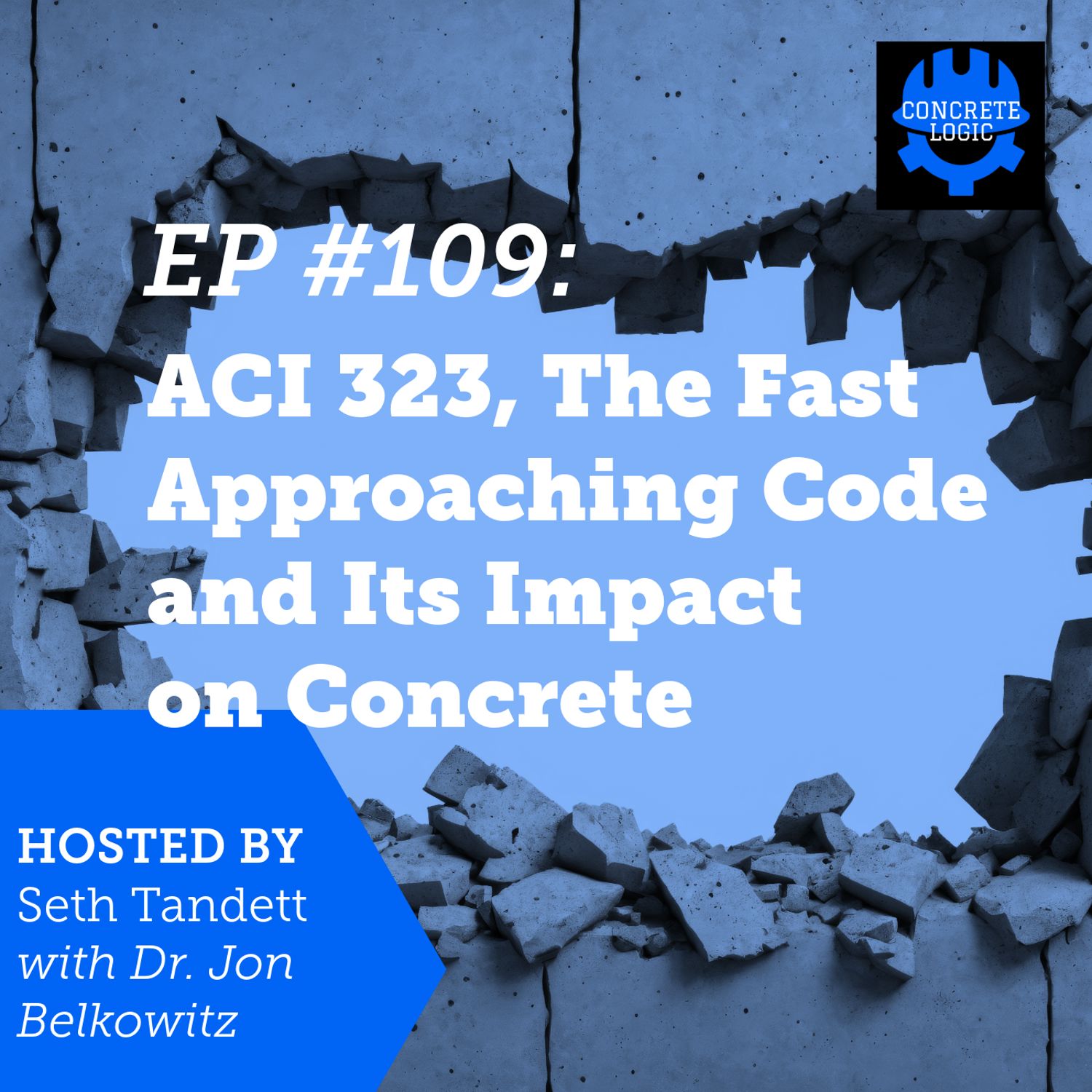EP #137: Silica Fume vs. Colloidal Silica in Concrete - Which One Really Performs?
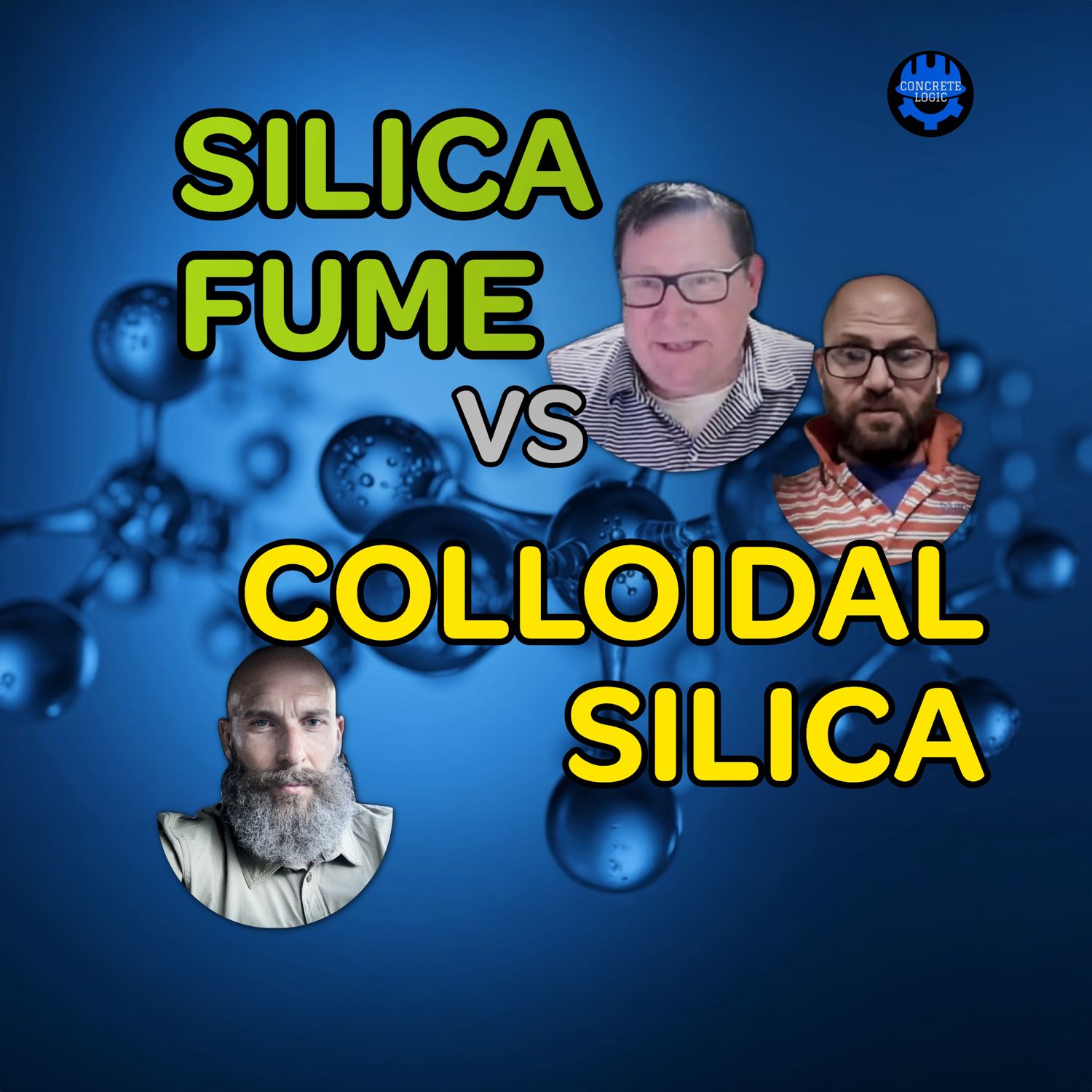
What happens when the concrete industry’s “wonder dust” meets its high-tech rival?
In this episode of the Concrete Logic Podcast, host Seth Tandett brings back Dan McCoy and Dr. Jon Belkowitz to challenge everything we thought we knew about silica fume. From bridge deck overlays that crack like eggshells to the real CO₂ math no one wants to talk about, the guys separate hype from chemistry and ask the only question that matters: What are we really asking this concrete to do?
What You’ll Learn
• What is silica fume really — and how did it end up in our concrete?
• How does colloidal silica change the way concrete performs in the field?
• Why bridge deck overlays using silica fume often fail before their time.
• How mix design mistakes turn silica fume into a “volatile” material.
• Why colloidal silica can actually cost less than silica fume.
• What’s the environmental truth behind “green” cement substitutes?
• Why performance specifications—not recipes—should drive concrete design.
• The one ASTM document every purchaser should actually read.
Chapters
00:00 Introduction and Guest Introductions
01:36 Understanding Silica Fume
05:11 Colloidal Silica vs. Silica Fume
13:38 Practical Applications and Challenges
18:34 Cost Analysis and Environmental Impact
32:52 Exploring Concrete Associations and Data Sources
33:07 Understanding CO₂ Emissions in Concrete Materials
34:34 Debating Environmental Impact of Fly Ash
36:03 The Role of Coal in Concrete Production
38:23 Analyzing Silica Fume vs. Colloidal Silica
40:10 Cost and Benefits of Silica in Concrete
41:23 Challenges in Using Silica Fume
43:03 Evaluating Cost Structures of Concrete Materials
45:22 Understanding Concrete Specifications and Purchaser Requirements
46:56 Concluding Thoughts on Concrete Practices
Guest Info
Dan McCoy, P.E. — R.L. McCoy, Inc.
Email: danmccoy@rlmccoy.net
LinkedIn: https://www.linkedin.com/in/dan-mccoy-48507730/
Website: https://www.rlmccoy.com
Dr. Jon Belkowitz, Ph.D., P.E. — Director of Research, Intelligent Concrete
Email: jon.belkowitz@intelligent-concrete.com
LinkedIn: https://www.linkedin.com/in/jon-belkowitz-phd-pe-53494719/
Website: https://intelligent-concrete.com
Concrete Logic Academy
Earn PDHs for courses built from real podcast episodes.
Start learning at https://www.concretelogicacademy.com
Support the Podcast
Donate to keep Concrete Logic independent: https://www.concretelogicpodcast.com/support
Shop KUIU gear through our affiliate link: https://www.concretelogicpodcast.com/kuiu
For podcast media services or sponsorships: seth@concretelogicpodcast.com
Podcast Partners
Intelligent Concrete
At Intelligent Concrete, we combine lab precision with field expertise to help you understand what your concrete is telling you. Our services include mix troubleshooting, forensic and petrographic testing, performance-based specification and admixture development, and training for engineers, contractors, and producers. Whether you’re chasing consistency, durability, or answers after a failure, Intelligent Concrete delivers the data and insight to solve problems and improve performance.
Learn more: https://www.concretelogicpodcast.com/intelligent-concrete
Credits
Producers: Jodi Tandett & Concrete Logic Media
Music by Mike Dunton — https://www.mdunton.com
Connectivity
Host: Seth Tandett — Concrete Visionary & Host of The #1 Concrete Podcast
LinkedIn: https://www.linkedin.com/in/sethtandett
YouTube: https://www.youtube.com/@concretelogicpodcast
Website: https://www.concretelogicpodcast.com
Like, subscribe, comment, and share this episode to help more people think critically about concrete. Let's keep it concrete!
Seth Tandett (00:00)
And welcome to another episode of the concrete logic podcast. And today I have the one and only Dan McCoy coming back. I came. don't, I, I, yeah. ⁓
Dr Jon (00:09)
coolest guy in the concrete industry.
DAN MCCOY (00:09)
I love it.
I am
going to vehemently deny that. That is not true. Everyone, remember, all glory is fleeting.
Seth Tandett (00:16)
Okay. Coolest. How about
this? You're the coolest one in this group.
DAN MCCOY (00:21)
that's nice, but it's not true. It's not true.
Dr Jon (00:21)
And I'm gonna
Seth Tandett (00:22)
There you go. And,
Dr Jon (00:23)
stay on that. Yeah. Who cares?
Seth Tandett (00:24)
and Dr. John, Dr. John's back on the show. This is his hundredth show.
DAN MCCOY (00:30)
It's gotta be close to that. Like he is, blue filter. He, he, you know, it's like the SNL. Like what ho, who's hosted the most SNLs? I swear he's like, he's like the most often host. I mean, look how he's behaving now. It would be hard to believe. Second cross between, he said cross between Belushi and Hanks.
Seth Tandett (00:35)
huh.
Yeah, I don't even know what he's doing. I don't even know the stupid...
Dr Jon (00:46)
Help them.
Seth Tandett (00:48)
The software could do... Don't do that. You're on some rinky dinky internet out there in Indiana. It's gonna break it. We just... We're lucky to get you on video. Yeah. Well, I... So today, I... The reason I got these two fellas on...
DAN MCCOY (00:54)
You could screw it up.
Right.
Dr Jon (01:01)
How many times have we tried to do that and it didn't work?
Seth Tandett (01:13)
I got an interesting text from a colleague who I was sharing information that Dr. John sent me on colloidal silica and sent it over and the response I got was silica fume is a cheaper, better option. So today we wanted to talk about, I think first off, if we could talk about what silica fume is, where it comes from.
how it's used in concrete. And then we can do the same for clodio silica and do a comparison with everything in life. There's not perfect solutions. There's only trade-offs. So let's talk about those things too. So Dr. John, why don't you tell us what silica fume is?
Dr Jon (01:56)
Yeah, Dan,
can I define both silica fume and colloidal silica, bookcrete, labcrete, and then Daniel, you take realcrete, streetcrete?
DAN MCCOY (02:06)
Sure.
Seth Tandett (02:07)
Sounds like playing.
Dr Jon (02:08)
So silica fume without using chat GPT is a byproduct of ferro silicone alloy production. It, as I understand it was originally brought to the concrete and construction industry from Norway and China by a gentleman named Per Fidishtol.
And what they used to do is they used to out gas this fumed silica or the silica used to just go out the smoke stacks and used to fall on people's cars. So Pear collected this shit, started putting it into concrete. And then from there they started finding the benefits of it, whether it was densified or undensified silica fume. And ultimately it's either undensified, densified powders.
or you can have it in a silica slurry. It could be anywhere from I think 89 to 98 % or 95 % pure silica. It normally comes with a certain level of contaminants. And the reason why we like it is it's an amorphous form of silica, meaning it's in a state that is ready to react with calcium hydroxide as a byproduct of our cement hydration to create more of the backbone of concrete strength, the calcium silicate hydrate.
The difference between that and nano silica, most of the silica fume that we use is on the micron size. Some of it, the tail, tail, tail end of it is on the nano side, but the bell, the fat bell and the other side of the tail, it's all big micron size particles.
When you compare that to nano silica, we are only in the nano range between one and 100 nanometers on the bookcrete side and three to 100 nanometers on the labcrete side. And because of that one, we don't want to use it when it's in a powder. We use it in a suspension called a colloidal suspension of silica, so colloidal silica.
and it has a surface area a thousand times greater than that of silica fume or fly ash. Now the last piece of it, the last two pieces of it is one much higher purity because we are manufacturing something. This is not a byproduct. We've been using it for decades upon decades since the 1800s and if you eat ketchup, know, use printer ink,
You know, drink wine or beer, you've had colloidal silica because it's used as a clarifying or a suspension agent. Now, one other thing because, and I'll shut up in a second, Daniel, because it's on the nano size, we have a higher degree of pozzolanic reaction, a faster degree of pozzolanic reaction, and...
we get a higher degree of accelerated cement dissolution, meaning we get more bang out of one cementitious bug, ultimately creating an environment for a concrete that is stronger and lasts longer because of its resiliency to physical and chemical attack. Did I miss anything? Do you have any questions?
Seth Tandett (05:11)
No? Dan?
DAN MCCOY (05:12)
I think that was excellent.
Dr Jon (05:12)
Daniel.
DAN MCCOY (05:14)
No, no, I think that was excellent. I think going back to the comment, Seth, about
And that's what you get for anything, right? What's the value? Where's the benefit? And I will tell you that from my experience, the one thing that we relied on silica fume very heavily for was bridge deck overlays. I don't know. cannot answer you. This is why I went through my whole iteration in 2019 through 2020 about what are we asking this concrete to do?
There's some significant benefits with silica fume as far as strength production. And I get that. But the way it's treated mostly is in an addition. It's not so much a supplementary cementitious material to supplement that powder. It's normally used as an addition. In a standard bridge mix, there's a really good study. And I wish, I just tried to look it up and I just crashed my phylloxplorer trying to find it. But there's a really good study.
that involved in the 1970s what silica fume and bridge deck overlays do does and then can we incorporate the silica fume into normal concrete as well so normal bridge deck concrete. What you found in the difference was back then it's kind of changed as John mentioned you can have densified undensified slurry form.
Normally in the 70s and 80s you ended up with a slurry form where the producer, the concrete producer would use it in slurry form to inject it into the ready mix as it was ready to leave the plant. Nowadays it comes densified and it's ready to go in a water soluble bag. The problem is when we look at some of the things we do, one of the things that's needed to break up that bag is water.
and usually an agent that is going to beat the hell out of the bag. Normally that would be a larger coarse aggregate and a combination of a medium coarse or a medium coarse aggregate. So what we found out with the overlays was we did everything you weren't supposed to do with silica fume. So we really didn't give it a good chance. We used it in a very high dosage. It was a, yeah, yeah, that's it.
Dr Jon (07:16)
Yeah, that's why I'm shutting off my camera is I'm trying to say bandwidth to get this fucking stuff. So I apologize.
DAN MCCOY (07:18)
yeah.
Well, boy, see, but a
lot of people, I listen to Seth's podcast on my earbuds. So when you point to something on the screen, now I can't point to it. But let me read the title for everybody. So this was silica fume, micro silica concrete in bridges in the United States. And it was from the 1970s, 1980s. 5 % to 15 and 1 half percent by volume.
Dr Jon (07:43)
look five to fifteen and a half percent.
Seth Tandett (07:44)
Mm-hmm.
DAN MCCOY (07:49)
And they were almost all of those, those dosages were, like I've said, normally when you're dealing with a slag or you're dealing with a fly ash, those are replacements. Usually with silica fume, it's an addition. So in the overlays that we ran into trouble with, they were high concentrations of 7 % silica fume addition. So you took a 658 mix.
Dr Jon (08:02)
Mm.
DAN MCCOY (08:16)
plus now you're sitting at 708 pounds of semen tissues with a silica fume that likes to be volatile. It's water hungry. And then the next thing you try to do in ⁓ the warning on silica fume is, don't try to use it with a low water cement ratio either. Well, we end up using a water.
Dr Jon (08:23)
Mm-hmm.
look at this Daniel.
Do you see that water cement ratio?
DAN MCCOY (08:37)
Yeah, yeah, so yeah, so these water cement ratios are 0.35, 0.34, 0.33. Those are all very common. But I wanted to, the difference between what John's showing in that paper and what we're doing now is they generally use, and they get into it a little bit, about the use of a densified versus undensified versus a slurry form. And many of those were slurry forms. So they did go in.
Dr Jon (09:04)
you
DAN MCCOY (09:04)
they did go in as almost as a saturated condition. And one of the things that
that I get concerned about is we're already using a low water cement ratio. Yes, it's attained with that, but now it's attained with that low water cement ratio. We're using that 708 pounds of cementitious full as incorporating it. And now we're looking at ⁓ the aggregate that we use for an overlay, which is a fairly small coarse aggregate. It's like a 3 8. So we're doing everything wrong to the silica fume. We're not really giving it a good chance in overlays.
⁓ And one of the reasons to put that in there ⁓ was ⁓ to slow down ⁓ corrosion, right? We wanted to, we wanted our rapid, are you, am I going too fast for you Seth? No, keep going. So one of the things we wanted to do was look at our chloride penetration for that because we're gonna deal with a lot of that in the roadway.
Dr Jon (09:49)
Mm-hmm.
Seth Tandett (09:55)
No, keep going.
DAN MCCOY (10:05)
That's everything that was done in the mix design to try and protect the surface. Now what happened in the field a lot of the times was that it was very, I used to call it, you know, I'm a nuclear fan. So I used to call it tickling the dragon's tail, right? Every time you deal with, every time you deal with a mix that's that volatile, it can turn on you in a hurry. So if, if
Dr Jon (10:23)
What?
DAN MCCOY (10:27)
if the water-cement ratio ends up being a little less than what you thought or a little more than what you thought and now you have runaway evaporation and evaporation rates increase the silica fume increases the internal temperature of the concrete with its reaction it just lights it on fire right? end up with internal temperatures of like hundred and fifty hundred sixty degrees in an overlay that's only supposed to be picture this it's only supposed to be thirty feet wide maybe a hundred feet long but it's only an inch and three-quarter thick
where's all that shrinkage happening? Eventually that evaporation has to leave, the water has to leave, and that's what you end up with. It's very prone to shrinkage cracking ⁓ and plastic shrinkage cracking. Now, in before, ⁓ one of the things we always did to fix that was go back later with an epoxy penetrating sealer.
Dr Jon (10:53)
Ugh.
DAN MCCOY (11:18)
The breaks that we were getting on those, they were outstanding. I mean, we're talking eight, 9,000 PSI. But you have to ask, again, what do I want to get out of this concrete? And for the overlay, all I needed, there were studies in Missouri saying that they were opening to traffic on pavement that was at 2,500 PSI. Well, if I can do that.
Dr Jon (11:39)
Yeah.
DAN MCCOY (11:40)
God, all I need is 3500 to 4000 psi. I don't want to, and John just put something else up that was really great by Yarnulik. So when you're looking at the strength differential between your subsurface or your structural slab and your.
wearing surface, you don't want too much of a difference in there, right? You don't want too much of a delta between those two. ⁓ And they're acting different, they're made of different materials, ⁓ there are some nasty things that happen in that interface. So that's why instead of going with the silica fume, now the author of who questioned you of what's the benefit, it's again the argument of I'm not chasing compressive strength.
I don't care about that. What I'm looking for is what do I want to use the concrete for, right? Performance based specifications. I want it to be 3500 to 4000 PSI.
I want it to have low shrinkage rates. want it to not be real, when I say low shrinkage, I want it to be not susceptible to plastic shrinkage because the way I'm using this, I'm submitting, it's a lot of surface area for the amount of volume. So this is what you're asking of it. So that's where it became a lot better to lower the cement content, take out the silica fume that was somewhat volatile.
That's just for us pouring it. It doesn't say anything about the actual production process, which I'll get to just after I explain why this colloidal silica was used instead. So then we use a colloidal silica that was replaced at, you know, I think four ounces of one that was blended for internal cure and eight ounces of one that is known commonly as liquid fly ash. Those are colloidal silica. So with 12 ounces per hundred weight.
dosage of a colloidal silica I'm able to get rid of a lot of those problems and get what I want which is a wearing surface right I don't when we look at a micro or a nano scale the cracks that you would see in the micro cracking that maybe you couldn't see from a micro from a micro silica silica few
that would inevitably happen either between the tines or when you start to groove. Those cracks to a chloride and water particle are absolutely like the Grand Canyon. You're just letting them all in. Now the whole thing we tried to do was reduce permeability with our silica fume. Well, we're defeating the purpose. I mean, if we build the world's strongest wall but then we put slits through it that anybody can sneak through, I don't know what good the material of the wall did because it's not there where anything's sneaking through.
So that's one of the, we said if we can reduce that cracking and the cracking potential, maybe even throw some fibers in there to give some more nucleation sites so that that can hold a little bit better. want to, now I want to go to the production side to where you throw in those silica fume bags and the guys don't, when I say the guys, mean the ready mix producers really don't like handling them. And I totally understand. So what you end up with is picture a truck.
dry wet batch, it doesn't matter, but it goes in. The silica fume is not usually in a silo, right? It's usually in an on-demand type of thing, so it's sold in pallets. So now you've got to find a place to store and keep these pallets dry. They're in bags. So depending on the dosage, now either someone in QC at the plant or the driver himself has to actually physically get out and load these bags.
up into the hopper of the ready mix truck. Now I've seen things before where, well, you know, what do we do with these bag corners and these bags that don't really dissolve that well because we're using lower water-cement ratios for this type of thing. That was the old game, you know. And you didn't want to use too much water because then you could induce runaway evaporation and shrinkage.
Dr Jon (15:08)
In all fairness, they've taken care of the bag dissolving issue, but you cannot get past, and I'll shut up, the safety issue of some guy walking on the catwalk or climbing up in the middle of the morning throwing bags in, in a safety vest underneath a central plant mixer. That in itself, I don't care how the bags dissolve, you're never gonna get past that. Go ahead, sorry Daniel.
DAN MCCOY (15:28)
Yeah,
it's an additional labor load. it is a higher cost, not for the material, but just working with the material. if you give guys at a plant any choice on
whether, do you want to rig up basically an admixture in a tank that's plumbed in for our admixture system? Or do you want to physically and manually load bags? And then if you do use a lower water cement ratio,
Dr Jon (15:58)
today.
DAN MCCOY (16:02)
and you want to get rid of the bag issue because you're tired of finding bags, then you split the bag open and then you're pouring it in. Now you've got other concerns with micro dust particles that cause a little bit of a health hazard to the people around you.
Dr Jon (16:14)
And then if you want to
go to a slurry, normally those slurries have to be delivered the day of, the morning of, the week of. And sometimes when deliveries go to shit, because they don't stay in suspension very well, so when deliveries get delayed, the job site doesn't continue. That's what we had in the Greater Toronto area. They were using silica slurry.
DAN MCCOY (16:22)
Yeah.
Dr Jon (16:36)
Material got delayed because of traffic and they're hey we have this colloidal silica this e5 and Holy shit, they they use more than we recommended and they fucking fell in love with it stickier than any freaking shot creep mix they ever used Yeah, sorry
DAN MCCOY (16:48)
Oh, sorry, I didn't go to that. yeah, when you're placing silica, fume has a tendency to be a lot
sticky. Like if you're listening to this right now and you're a residential or commercial guy and you've never done DOT concrete, the first time I ever put them, I have only done DOT. And then the first time I ever put a mag on some commercial concrete, was like, Oh, this is, this is really nice because everything I was used to for years was just a sticky mess.
And that's just what you were used to in because you had a lot of those. You had a lot of that going on where you ported a very low slump with something like a silica fume in there. I wanted to get back to this is going to tie in Bob Higgins work with sublimation along with.
Dr Jon (17:31)
Can we do cost
real quick? Because that's what I think homeboy said before we talk sublimation
DAN MCCOY (17:35)
Homeboy said about cost,
I want to tell the difference in the benefits between, I'm not so much getting on silica fume, but I'm getting on the benefits of what colloidal silica does.
And I want John, I'm to, I'm throwing him a curve ball here, but we talked about sublimation, Bob Higgins did about even just the light source. So it's one of the things we're concerned with, with that lighter evaporation of the concrete, even at the surface. So what I want to throw to John is, John, why don't you tell everybody a little bit about what colloidal silica does with the water, i.e. the glassy nature of water.
Dr Jon (18:11)
So there's a wonderful effing paper that was written by MIT. It was something Polank. I can't remember his last or his first name. But it was on the glassy nature of water in cement. And there's three types of water that we know about in cement. There's bulk water that can freeze and thaw and can cause erosion, corrosion, alkali silica reactivity.
Then there's chemically bound water. That's water that's not necessarily water, but definitely isn't a solid yet. And what it's happening is, is that it's being incorporated into the chemical reactions. Whether that's alkali silica reactivity, or in our case,
that we like, the superhero of concrete, calcium silicate hydrate. Then there's chemically incorporated water, which is not really water anymore. It's water that's really been trapped in the fractal network of our calcium silicate hydrate, because calcium silicate hydrate is not a crystal.
In the best of papers by I.G. Richardson, Andrew Allen, they talk about calcium silicate hydrate as an amorphous-like crystal, meaning it's more disorganized until you go to a really, really, really small level where at the nano level, it starts becoming a little bit more organized. When we look at it at the micron scale, within that fractal network, there's chemically incorporated water that's restrained within about 3.4 nanometers.
Now according to this guy, Polank from this paper back in 2007, 2008 about the glassy nature of water, when we can find water...
Seth Tandett (19:50)
6.
Dr Jon (19:53)
into these small areas of concrete and that water can't move, now it goes from having the ability to freeze thaw, corrosion, erosion, and other shit to providing strength to the concrete because it has this more glassy or ceramic nature. And that paper, went as far as identifying the strength of that water that was ultra-confined. I'll try to find that paper here in a second.
Go ahead, Daniel.
DAN MCCOY (20:20)
No, so that's what I was going to get to. Now, when it comes to cost, I'm
Dr Jon (20:24)
Wait,
Seth had a question.
Seth Tandett (20:26)
Yeah, I think I found it. it a board dallo or whatever paper?
DAN MCCOY (20:26)
sorry, sir.
Let's say Bordello.
Dr Jon (20:34)
share it real quick.
Seth Tandett (20:35)
I don't have the paper, I'm just searching.
DAN MCCOY (20:37)
he's looking
for. So while you two are finding that, I'll just go on and define. think one of the things that was questioned was the cost versus the benefit. And I guess I was excited about the question that Seth, you received because I know we're a fickle industry and we only care about costs for the most part. And ironically, in this case, usually in my bridge concrete, suppliers, meaning
Dr Jon (20:39)
Thank you, everyone.
Seth Tandett (20:45)
Yep.
DAN MCCOY (21:00)
Ready mix producers. Sorry, I get that wrong all the time. I call them suppliers. John calls them producers. So ready mix producers. They tend to have higher prices with silica fume because of the nature of purchasing the product, storing the product, and administering the product because it's not put in every mix. So usually what I see, if I would take a normal, let's say a
Dr Jon (21:05)
suppliers.
DAN MCCOY (21:22)
what I would call my touchy mix, the one that I just went over for our old overlay mix. That on average was close to, this was several years ago because we pretty much replaced it, but you're basically $250 a yard for something like that. And then we come back and we look at the one that was kind of designed to work with that with the colloidal silica replacement. And now you're looking at something that was
back then just to compare apples to apples was like $165 a yard. So not only was it better performing for what we wanted the concrete to do, it was also less expensive. Right?
Dr Jon (22:03)
And we could do the math on the cost of it real quick. I mean, let's say if we assume the bought price was $500 a yard and the sold price, the real tail price is $1,000 a yard. it is. Oh wait. Nope, that's not it. I mean, that's a pretty easy calculation if you guys wanna go through that math real quick.
DAN MCCOY (22:25)
No, I think I just did it with real world, but you can...
Dr Jon (22:27)
Yeah, I did it the other day. It was like $23 or something like that per year. Go ahead.
Seth Tandett (22:32)
Let's a couple things push back on you Dan a little bit. So your experience is with silica fume is it's solely on the bridge deck overlays with being you know would you say one and three-quarter inch or something like that?
DAN MCCOY (22:47)
So there was also the, so it's bridge decks and bridge deck overlays. The bridge deck overlay was, like I said, we didn't give, I don't think we give silica fume a fair shake. So if there's any silica fume lovers out there, I don't think we gave it a fair shake because we used way too much of it in that mixed design. And now the bridge design,
Seth Tandett (22:57)
Right.
Dr Jon (22:59)
for Rob.
DAN MCCOY (23:06)
mixed concrete that was also thrown in you had a choice back in the day you could you could use a 658 with either a 3 % silica fume addition or you could use a 658 with a 30 % slag replacement and all of that was meant to chase permeability. So that's the and even even on the bridge deck concrete where it was 3 %
addition, it was still a pretty hot mix. And that's one of the things that I want to be careful with. I mean, it was literally a hot mix. That's one of the things that I want to urge, you know, with caution with people that want to use a silica fume now with say a blended cement, like a type 1L blended cement, we've got finer particles. So we know and we've looked through maturity, we see
we see higher temperatures, early onset temperatures, with correlating lower strengths as compared to a maturity curve from a type one. So we end up with higher Fahrenheit hours or Celsius hours.
we end up with higher with lower strengths in those early phases. So that higher strength is one of the, or that higher temperature is what I get a little concerned about because those are the things that early onset lead to, you know, some plastic shrinkage. And then it also leads to thermal shock.
And one of the things I don't want to see is I don't want to see a large variation, regardless of the volume of the pour. I don't want to see a large variation between the ambient temperature, the temperature of what I'm placing the concrete on, and that heat of the concrete several hours after placement. And usually with a silica fume mix, you see higher induced temperatures.
as we go four, five, six hours afterwards, you know, up to 145, 150 degrees, when you know that even in a large mass pour, which I think ACI just defines as 18 inches, I can't remember. But if...
It's the thermal differential that you're looking for of about, I just judge myself, I want about 30 degrees. Well, if I'm only playing with a 30 degrees difference and it's a 75 degree day out and I've got my temperature up at 125 degrees six hours after pour, I'm a little worried about it, right? I'm trying to make a good pour out of it. So the better I can keep that concrete temperature post pour with the ambient temperature,
Or at least maybe not let the ambient temperature have any say in it. So that's where you come either with your cooling or you come with temperature control about insulating. So you have more of that. You know, I remember talking to NDOT thinking
Well, we're trying to control that. So maybe do we need to just limit our pores for overlays to be less than 0.05 for our evaporation rate? And then do we need our ambient temperature to be less than this? I mean, if we took everything that we needed to make it work from an environmental situation, we would only be pouring between
Let's say March 31st to maybe May 1st at night between 2 and 4 in the morning, depending on what the wind speed was. That's literally... ⁓
Dr Jon (26:17)
⁓ 8 p.m. at
night till 4 o'clock in the morning would be, you'd have a nice window, you know.
DAN MCCOY (26:23)
No, well,
but you say you say 8 p.m. But you're you're forgetting. Well, the one thing you have to do is let the aggregate cool down, John. We've had so now we've had this aggregate that's been heated all day in piles. And now we're going to start pouring at eight o'clock just because the sun went down doesn't mean that the aggregate didn't retain that temperature in the mix. So.
Dr Jon (26:41)
they can do that with sprinklers.
They can shade the aggregate. I mean, that they can handle ahead of time, Bubba. Don't worry. We got it. You just let us know when we can deal with traffic, because that's the hardest part, is getting the trucks on the road.
DAN MCCOY (26:50)
It's the truck.
Yeah, traffic
is a huge concern when you're trying to time these mixes out. like I said, think when I said tickling the dragon's tail, was serious. It's just a volatile mix, the more silica fume that you throw in. OK, well, so at Los Alamos, they would do these things to judge critical reactivity. they would. OK, well, they would.
Dr Jon (27:03)
What does that mean, tickling the dragon's tail in the nuclear world,
I did this.
DAN MCCOY (27:14)
place a little plutonium core and then they would reflect all the neutrons coming off of it and they would see how close they could get to measure that reaction. was tickling the dragon's tail because if you drop that, you went critical. And then you created this blue ionization that would spread radiation throughout the air. It's actually pretty fascinating if you look it up, but it's to me an unnecessary risk given the objective. ⁓ And I think that's what we're
Dr Jon (27:25)
No, we don't know.
Wasn't there a movie about that with
John Cusack?
DAN MCCOY (27:38)
You're right. was John Cusack and Paul Newman. Paul Newman was the general. I can't remember. But anyway, that's what it was. I think that's what we do with some of these poor is when we don't look, we meaning engineers and asset engineers and say, what do we want the goals to be for this? What performance do we want out of it?
Dr Jon (27:41)
I'm looking it up.
DAN MCCOY (28:03)
And you'll generally find that with a more flexible miss at a lower compressive strength, with less vulnerability to cracking and shrinkage, you're going to get a better longer term performance out of your wearing surface, because that's what we're dealing with. Now the same thing could be said for bridge concrete as well. mean, all you're really reaching is an everyday 4,000 PSI.
but we try to make it complicated because it's bridge concrete. So it really doesn't have to be. Really, really doesn't have to
Dr Jon (28:30)
Well, or we can overcomplicate it.
Seth Tandett (28:31)
So.
So using colloidal silica gets rid of some of those complications.
Dr Jon (28:37)
And when it comes to silica fume, if you like really stick to the silica fume association manual, folks don't use silica fume right. It's not just the bags. It's when you're supposed to have the cement touch the other raw materials and it's rarely at the ass end of the mix. And that's what normally everybody does, supposed to be in the head. And even when you put it in the head, Dan was already talking about, hey, those bags still dissolve, but they don't dissolve very quickly.
Like they're designed not to dissolve quickly because they're transported in a very extreme environment. So inevitably you don't get the silica fume doing what it's supposed to unless you're willing to plummet into and that requires either a pig or a silo and who the F is ready to do that. and they're.
DAN MCCOY (29:24)
I mean, ironically.
Dr Jon (29:25)
Wait, there was one guy for a long time selling silica fume to the US and he's the guy who wrote the silica fume association manual. His name was Tony Kajundic and in lieu of selling it to the concrete industry, he started selling it back to the steel industry because they didn't give him any problems. They know how to use it and they were consistent. Concrete isn't. Go ahead, Daniel, sorry.
DAN MCCOY (29:50)
Yeah, ironically, if you could put it in a slurry form, you could also use colloidal silica then with your micro silica slurry form to leave it in suspension longer. So guess there is a benefit if you use that the slurry. But I really don't think that's necessary. I think that there's definitely...
Seth Tandett (30:03)
Use them both.
DAN MCCOY (30:09)
I think one of the other things that was said from your comment, Seth, that you got was the environmental benefit of using the silica fume because it was a byproduct of the smelting process, right? I don't give anything a free pass. If you're going to be a true environmentalist, you have to look at everything. So just because it's a waste product doesn't mean it gets a free pass. In my mind,
Seth Tandett (30:21)
Yeah.
DAN MCCOY (30:29)
if I've, what did it take to get that one ton of silica fume? And usually it's a one to one ratio with cement. It's about .9 to a pound of CO2 per pound of the silica fume.
Seth Tandett (30:44)
Where'd you pull that from?
Dr Jon (30:45)
Yeah, I think it's much lower than that, Baba. I-I-A, I would love to be wrong.
DAN MCCOY (30:50)
Well,
0.5 to 2 and 1 half tons of CO2 per ton of microsilica.
Dr Jon (30:56)
0.5 to 2 and a half. Are you looking that up at ChatGPT?
DAN MCCOY (30:59)
wide range. When I did it before it was point
you guys push back on me but I mean when you think about the smelting process you have to include that. I know that they don't you know they consider well that's downstream and it's a waste but if we're really fighting co2 we should do everything we can to remove all co2 production.
Seth Tandett (31:15)
Yeah, I agree with that. They put all kinds of garbage and concrete to save the planet.
Dr Jon (31:16)
gonna get Uncle Rob on this and his...
DAN MCCOY (31:21)
you
Dr Jon (31:22)
What's wrong
with that? Concrete is a great garbage can.
Seth Tandett (31:25)
I guess.
DAN MCCOY (31:26)
It is, but I think it's, you know, when...
Are you a true environmentalist or are just chasing? Yeah, right.
Dr Jon (31:28)
As long as you admit it. Like when
they were putting CO2 into concrete. Or tires. that one. That tires thing killed me.
Okay, what am I looking for? EPD?
DAN MCCOY (31:40)
Yeah.
Dr Jon (31:42)
Yeah. You know, do you know that Daniel...
DAN MCCOY (31:43)
Yeah, APD of silica fume. This is fun. This is on the fly learning.
Seth, you could cut this out later so it just cuts to John and he just sounds brilliant.
Seth Tandett (31:51)
Yeah, if you do check GPT, says silica fume is 0.02 to 0.05 pounds of CO2 per pounds. And then.
Dr Jon (32:01)
Yeah, we don't want pounds. Okay,
CO2 per pound. So let's do it this way. We convert 658 divided by 1.68588. We got 300, 400 kgs. Right? So what did you say your number was? 0.02?
DAN MCCOY (32:20)
Mm-hmm.
Seth Tandett (32:24)
And I just call it .03.
Dr Jon (32:26)
So that's 19.74, then you divide it by 1.6588. That still sounds like bullshit.
Seth Tandett (32:34)
Yeah. Well, it's this thing searches the same, the same.
DAN MCCOY (32:36)
But keep in mind that
most of the mixes, and I mean a majority of the mixes, use silica fume as an addition, not a replacement. So no matter what we're doing, we're increasing the CO2 in that yard of concrete.
Dr Jon (32:52)
We wrote an article on this for ACPA. Daniel, do you remember that? The American Concrete Pumping Association.
DAN MCCOY (32:56)
with JCPI.
You know, there's a lot. There's the concrete pipe association, concrete pavement association. There's a lot of ACPAs.
Dr Jon (33:04)
pavement? I know.
Seth Tandett (33:08)
Here you go. So I asked Chet GPT where it got its information on the CO2 per pound for silica fume and it pulled the data from the company that sells silica fume.
DAN MCCOY (33:19)
Yeah.
Dr Jon (33:19)
Well
that's what that who is supposed to have it, but we need it in kg of CO2 per pound. So what did you say it was 0.02? It should be right, the kg CO2 equivalent per pound.
Seth Tandett (33:29)
Yeah. You want the GWP is what you're asking for.
Per what is it Elcom the company sells it?
Dr Jon (33:44)
The Elchem or Pharaoh Globe. That's who Uncle Rob used to work with was Elchem. So it should be...
Seth Tandett (33:50)
The high end, ⁓ they're
saying 0.10 kilograms of CO2 per, yeah, whatever.
Dr Jon (33:58)
No, the whatever is important. Is it pound or kg? Okay, so was 0.1 whatever.
Seth Tandett (34:01)
KG.
0.10.
Dr Jon (34:06)
How many pounds or kgs are in a pound? 2.2?
DAN MCCOY (34:12)
2.2... No! It's the inverse of that. 2.2 pounds in a kg.
Seth Tandett (34:18)
Yeah, if you want the equivalent in pounds, it says 0.045 pounds of CO2 per pound.
Dr Jon (34:18)
That's what I just said.
There's no
fucking way. Dan's right. They're skipping some very important step. just because it's a buy crap, a byproduct doesn't mean you get a free pass. Like what the fuck, dude? Even Pondash, even Pondash has a 0.21 and Cement has a 0.42.
Seth Tandett (34:31)
Well, I'll send you the link to.
DAN MCCOY (34:34)
Yeah, I that.
No, and I completely disagree
with that because you have to burn coal to get ash. So you're looking at 17 to 18 pounds per pound of fly ash. I still, if you're going to be a true environmentalist, you better go with it. If not, shut your mouth.
Dr Jon (34:47)
Okay, and then you have to reclaim it and clean it. It should be equal to, yeah.
Seth Tandett (34:53)
Yeah.
Yeah, Flyash has the lowest per this. 0.01. Hey, come on now.
DAN MCCOY (35:00)
Yeah, right! Yeah!
Dr Jon (35:01)
Fuck bullshit, man. That's such horseshit.
And you know,
nobody is looking past.
DAN MCCOY (35:08)
⁓ Yeah, let's be
nice, we've got kids listening to this show. ⁓
Dr Jon (35:12)
Great
kids, Uncle John is here and let me teach you the use of a good word called horse shit. When somebody's lying and you just don't know what to say to call them out on their bullshit, you can yell emphatically, horse shit. And that's from your Uncle John. Make sure you tell your parents.
DAN MCCOY (35:31)
So Seth, this is exactly how we remain on the naughty list. And this is why Bob Higgins has such great shows. I mean, he just gets so deep into it and enthralls me. And you get us two morons on, and it might as well be a comedy podcast that isn't even funny.
Dr Jon (35:40)
I'm alright with that!
You know, you've got to have a little levity with the bullshit that we deal with. Right? Like, if you can't laugh at it, you're going to freaking cry. Like, OK, can we just talk about this concrete right here? Look at this.
DAN MCCOY (35:59)
Right, right, that's true.
Seth Tandett (36:03)
Wait,
DAN MCCOY (36:03)
Sure.
Seth Tandett (36:04)
wait, wait, wait. I wanted to dig a little further. I answered Dan's question about how many pounds of CO2 are in coal. Because you got to start there, right?
DAN MCCOY (36:05)
Hold on. Let's set go.
Dr Jon (36:08)
Thank
question.
Seth Tandett (36:16)
How many pounds do you guys think of CO2 per pound of coal?
Dr Jon (36:16)
Yeah.
Coal what? Coal consumption? But what is that? Coal consumption? Coal what?
DAN MCCOY (36:21)
⁓ it's tremendous.
Seth Tandett (36:22)
Three.
three pounds.
DAN MCCOY (36:28)
no, no, it's so it's like a British thermal unit is it sits there. What's the potential energy? And that's what it's saying. Burn it off. If you burn it off, here's here's what you've got.
Dr Jon (36:32)
⁓ okay, okay, okay, so I understand.
Seth Tandett (36:34)
Yeah.
Dr Jon (36:37)
So if that's three kg of CO2 equivalent per kg.
DAN MCCOY (36:40)
Right, but how much coal do
Seth Tandett (36:41)
No, no, no, no,
DAN MCCOY (36:42)
you
Seth Tandett (36:42)
that's pounds. That's pounds. That's pounds.
DAN MCCOY (36:42)
have to burn to get... Right, and how much coal do you have to burn to get one pound of fly ash? That's the key. So I have to burn how many pounds of coal at three pounds, how many pounds to get one pound of the fly ash that's left over? That's where I think I came up with my number roughly of 17 or something.
Dr Jon (36:54)
That's a great fucking question. So what's the efficiency of that? What's the efficiency?
Seth Tandett (37:06)
man, we're going down a deep rabbit hole here.
DAN MCCOY (37:09)
I know, but everybody else says, don't pay attention to that! What is it?
Dr Jon (37:10)
But nobody's doing this, And
Seth Tandett (37:10)
It's fine. Yeah.
Dr Jon (37:13)
when you read ACI 323 that really governs this mishpacha, this mishagas, they'll even tell you, we don't consider that because we don't have all the data.
Seth Tandett (37:23)
my gosh.
For every one pound of fly ash, need roughly, you need roughly eight to, you need roughly eight to 20 pounds of coal.
DAN MCCOY (37:25)
How many pounds of coal for every one pound?
Dr Jon (37:25)
And in the eye.
DAN MCCOY (37:36)
So there you go, eight times three. That's 24 pounds of CO2 for one pound of fly ash. That's pretty basic math, right?
Dr Jon (37:36)
Yeah buddy. And convert that to kg that's 12. That
Seth Tandett (37:46)
Hmm.
Dr Jon (37:46)
brings
it to 12 kg CO2 equivalent per kg of ash.
DAN MCCOY (37:48)
But your infallible
AI that pulled from resources said, oh, 0.2, 0.25. How can that be? If I have to burn eight pounds of coal to get one pound of fly ash, how can you not count anything before that? If that's the case, then I shouldn't have to count transportation of that silica fume to the plant. But yet I do.
Seth Tandett (37:59)
⁓ boy.
Dr Jon (37:59)
Because they're not counting everything before that. What they're doing is they're treating it...
Seth Tandett (38:02)
Yeah.
Dr Jon (38:10)
Right, right, they're not.
They're doing the same thing with sand. Sand is only 0.05 to 0.01. What, you don't have to reclaim it?
DAN MCCOY (38:21)
They're defining, they're making up their own definition.
No, I know, I know, no, we're not getting into that right now. We were having a nice conversation about silica fume. Who brought up, who brought up greenhouse gases? Shame on me. No, it was me. I brought it up and I said, you know, they like to say...
Dr Jon (38:26)
Get involved, that's all I'm No we weren't. Seth.
Seth Tandett (38:35)
Ha ha ha!
Dr Jon (38:36)
Who's the first one
who cussed, Seth?
Seth Tandett (38:39)
Yeah. Put it on.
DAN MCCOY (38:40)
On the record.
Dr Jon (38:43)
Check the transcript!
DAN MCCOY (38:44)
So did we answer, let's go through that comment again. I want to make sure that we answered every benefit or every one of his arguments, It was a really good question. think basically he said it would have to be very valuable for me to want to replace it. And I tried to argue that everything that we use silica fume for in a lower concentration with colloidal silica, we get that benefit.
Seth Tandett (38:55)
Yeah.
DAN MCCOY (39:11)
a lot lower concentration. And then it's also less expensive and easier to work with in the field and for producers to use.
Dr Jon (39:19)
How much did you use per cubic yard, Daniel? What percentage? Silica fume.
DAN MCCOY (39:22)
So
four ounces of internal cure and eight ounces of liquid fly ash. Oh, silica fume. So the normal bridge had to be a 3 % increase, 658.03, about 20 pounds per cubic yard for bridge deck.
Dr Jon (39:25)
No, silica fume.
20 pounds at
50 cents a pound, which is 1,000 per twin. That's $10 per cubic yard.
DAN MCCOY (39:44)
Yeah, just material though, right? So you put it, yeah, so that's just material. So you put a markup on it and then a delivery and the cost of actually putting it in the mix, which ReadyMix, they don't like to do.
Dr Jon (39:47)
Yeah, that's what I'm saying. Just material.
Seth Tandett (39:58)
What, why do you...
If you're not using silica fume for... We probably said this earlier, but let's just go back to it. If you're not using silica fume as a... To replace cement, then what's the point?
Dr Jon (40:11)
Just the way some assholes add it to the concrete, you could do by weight of replacement, by weight of addition. Who gives a shit?
DAN MCCOY (40:15)
So by weight of replacement,
Seth Tandett (40:14)
No.
DAN MCCOY (40:17)
they're looking to lower permeability and they're looking to increase abrasion resistance.
Seth Tandett (40:23)
I got you. So like fly ash, kind of, sorta.
Dr Jon (40:26)
Yeah, you
could do with both percent addition or percent replacement. It doesn't fucking matter.
DAN MCCOY (40:29)
Although I'm not too sure
on CH consumption how well micro silica does versus fly ash. Do we know that?
Dr Jon (40:36)
No, it's basically
how somebody knows how to create a mix design. Percent replacement, percent addition, it's one half dozen of the other.
Seth Tandett (40:45)
So then if we don't use silica.
Dr Jon (40:47)
get to the same
place.
Seth Tandett (40:50)
So really, they just need somewhere to put silica fume, and they figure concrete is a good place to bury it.
Dr Jon (40:57)
Well, it does good things. Daniel and I have gone through that. Yeah.
DAN MCCOY (40:59)
It does good things. not, I'm,
I was looking apples and apples if I was going to use colloidal silica versus silica fume in my, as it's meant to use, like, let's go back to what do want the concrete to do? And I think there were, there were a couple of professors out there that actually said that you would be real surprised what silica fume would do in a really low dose concentration too, where you trade off, you trade off the problems that you have with
Seth Tandett (41:04)
One or the... Okay.
Dr Jon (41:19)
Yeah.
DAN MCCOY (41:24)
And when I mean low, mean less than 3 % addition.
Dr Jon (41:26)
Right, didn't
you guys use like 7 % Daniel, 7.5 %?
DAN MCCOY (41:29)
Yeah,
That was, that was 50 pounds a yard. and that's, yeah. Yes. And that's what you're dealing with with. that those were, that's what, that was the tickling the dragon's tail moment where I've got this large amount of surface area with a very low amount of volume.
Dr Jon (41:33)
Yeah, that's $25 a cubic yard. So now you've exceeded what the colloidal silica costs.
Now, when it comes to production, if I was a ready mix provider, I don't wanna touch silica fume, just like I don't wanna touch powdered pigments. You've gotta have a separate shack. Daniel said you gotta have a separate person to do. God forbid they're cutting the bags. There's no proof that it causes silicosis and Rich is running some project about has any plant ever complained or seen a problem with silicosis with silica fume, but it's still a pain in the ass and nobody wants to do it.
DAN MCCOY (41:55)
Correct.
No.
Dr Jon (42:16)
So the convenience of it and it's less expensive, screw that, I wouldn't use silica fume. And if Uncle Rob is listening, man, I love you, but I don't love using silica fume as much as I used to,
DAN MCCOY (42:28)
But there are benefits to it. I'm sorry, Seth, we're circling back again. What exactly was that comment?
Dr Jon (42:30)
There are.
expense we did it.
DAN MCCOY (42:36)
Do want me to, I think maybe I've
got it. It was really interesting. I thought it was, I thought it was a great question.
Seth Tandett (42:38)
No, I got it right here. Sorry.
These phones are... ⁓
DAN MCCOY (42:43)
Yeah.
Seth Tandett (42:44)
They tell you they get better, but they get worse.
Hold on. There's a lot of
Dr Jon (42:47)
Who's they? Who are you listening to?
DAN MCCOY (42:50)
Well, I
can tell you right now that I think 5G is completely horrible compared to the old 4G LTE network. But I probably can't say that. I'll catch a bullet in the head.
Dr Jon (42:58)
You just said it.
Seth Tandett (43:00)
I'll cut it out and post. Let's see.
Dr Jon (43:04)
This is a picture Daniel gave me.
Seth Tandett (43:06)
I'm curious what the cost structure looks like for this material. Colloidal silica is what he was referring to. It's a manufacturer product unlike silica fume, which is a byproduct of silicone or ferro-silicone manufacturing process. My guess is that it would be order of magnitude more expensive. That doesn't mean it has no potential, just that the benefits have to be very big.
Dr Jon (43:28)
Funny
he should use that statement because we're using around 0.2 to 0.4 % silica addition to the concrete mix. So we are in order of magnitude less in dosage, yet the price is less. So it's funny he used order of magnitude.
DAN MCCOY (43:48)
Right.
Yeah.
Dr Jon (43:51)
because 4-5
% in silica fume, we're using 0.2 to 0.4 % colloidal silica.
DAN MCCOY (43:57)
You know, it's all about the surface area, I mean, it's like James Carville. It's the economy, stupid. Well, in pozzolanic reactivity, it's all about the surface area. And you don't get down to you like that.
Dr Jon (44:09)
I loved it. I already quoted you once from this. Did you get that quote I sent you, Seth?
DAN MCCOY (44:12)
You
Yeah,
quote of the day, what are we asking this concrete to do? Which should be on everybody's mind. It shouldn't be just, honestly, when you're looking at a mix designer, you're looking at a proposal for the concrete, and I don't care what job you're at. Break it down to basics, stupid. What do we want the concrete to do? ⁓
Dr Jon (44:33)
And by
the way, if you're purchasing...
DAN MCCOY (44:33)
What are we asking
this surface? Is it a surface or is it structural? Is it mass concrete? What kind of stresses is it getting? I really think that's an important question to balance all that in.
Seth Tandett (44:45)
Yeah. I think that's it.
Dr Jon (44:46)
And if you're buying the concrete,
if you're buying the concrete, ASTMC 94 calls you the purchaser and it says, you ready for this, Dan? You're gonna fucking love this. When the purchaser's requirements are stated in the order different from those in the specification, the purchaser's requirements shall govern. If you're buying concrete from a ReadyMix provider, you shouldn't say, oh, I'm trapped in a box of specifications.
The specs that the DOT or the engineer gives you is the minimum specifications. If you want to add on top of it...
DAN MCCOY (45:20)
Correct.
Yep.
Dr Jon (45:22)
Read it, spill coffee on it, make notes. This is how you talk to the ReadyMix providers.
DAN MCCOY (45:26)
It is a great. It's a great document.
It is. It is a great document that that is probably one of the best documents that ASTM ever ever came up with for sure.
Dr Jon (45:33)
Okay, wow,
there's a colloidal silica document that's coming out that was written by this really cool dude.
DAN MCCOY (45:40)
That is true, but it's not out yet.
Seth Tandett (45:42)
Yep. Not out.
Dr Jon (45:44)
Hit that out, huh?
DAN MCCOY (45:45)
Why is there always a bird? There is always a bird in John Shaw. It's crazy. It's not the bird of peace. Yeah, it's not the bird of peace either.
Seth Tandett (45:46)
Blur that out now.
All right. I think we need to wrap it up. So hopefully I answered or we answered that text message I sent you guys. If not, I think my colleague listens to the podcast and if you feel like we didn't cover something, I could always ask these guys to come back.
DAN MCCOY (46:11)
or yeah, just shoot us an email, Seth. I'd be more than happy. It's getting people to understand that I don't think that there's anything exactly cruel or evil in the materials used in our industry. It's just how they're used and not having the education of how to use it. ⁓
Dr Jon (46:11)
Yeah.
Seth Tandett (46:23)
Right.
Dr Jon (46:26)
complacency.
They're lazy.
DAN MCCOY (46:27)
E complacency.
Complacency is a good word that John uses and I like it a lot. It's well, this is what worked five years ago, 10 years ago, 25 years ago. It should work again. you know, materials have changed and it's just what we have to deal with. if what isn't working before, then it's something we need to dial in and look at again. And you can do it with very short term testing like John's brought up before with.
dialing in exactly mixed compatibility. can get most of everything that you want to need in like a 72 hour period.
Seth Tandett (46:56)
Right.
Dr Jon (46:57)
Yep, 96 is like
pushing it, but 72 is pretty good.
Seth Tandett (47:02)
All right, Dan, thank you for coming on the show. And Dr. John, thank you for coming on the show. I will check out the show notes, the contact information. Dan's direct phone number will be on there. Along with, sure you check out how to donate to the show, how to join Concrete Logic Academy as well. Please make sure you check that out.
Dr Jon (47:06)
My chop liver.
Question.
DAN MCCOY (47:19)
I don't care.
Seth Tandett (47:32)
And there's other links in the show notes for you all to support the show.
Dr Jon (47:37)
What about a t-shirt for Daniel?
Seth Tandett (47:40)
Work. Sure. I'm working on a new logo, so we'll do that after the new logo comes out. All right.
DAN MCCOY (47:44)
Merch baby, merch.
It's
funny how I donate, you know Seth, it's funny how I donate more to the John and Bob Higgins shows than I do to my own. Because I value their shows more than mine.
Seth Tandett (47:56)
⁓ you're more welcome to change that on this episode. There you go.
Dr Jon (48:03)
Yeah, get some
banners. Get some banners on the Concrete Logic Academy, Daniel. Don't be cheap.
Seth Tandett (48:07)
There you go.
All right. That's it. Are you guys done?
DAN MCCOY (48:08)
yeah, okay.
Dr Jon (48:13)
Yeah, we're done.
DAN MCCOY (48:14)
Yeah, Dad, we're done. Thank you so much for having us on. It's a lot of fun. Talking about concrete is so much fun.
Seth Tandett (48:15)
Alright.
I know.
Dr Jon (48:19)
Yeah, maybe
you should wear sunglasses though.
Seth Tandett (48:22)
No, thanks, John. All right, until next time, let's keep it concrete.
DAN MCCOY (48:24)
Who?

Dr. Jon Belkowitz
Jon Belkowitz is the CEO of EDYSTON, LLC and CTO at Intelligent Concrete, LLC. Before Intelligent Concrete, LLC, he served in the United States Air Force from 1996 to 2006 specializing in Civil Engineering. His tour of duty introduced Dr. Belkowitz to a wide variety of concrete types and uses which were dependent upon the engineering practices of different host nation forces, developing nations, and disaster repair initiatives. Jon has worked in private laboratories on structural engineering and materials development projects to include the application of nanotechnology in concrete. Dr. Belkowitz has worked as a consultant on projects in the United States, India, Turkey, Africa, Italy, New Zealand, Australia, and Germany. Jon has worked as Chief of Materials for a 3D concrete printing firm, an advisor for NASA on 3D printing of concrete holds patent applications on 3D printing with concrete, and is an ACI member on the subject. Jon received his Masters of Mat Science from the University of Denver and his Ph.D. in Mechanical Engineering with a specialty in Nanotechnology in Concrete at Stevens Institute of Technology in New Jersey. Jon is a licensed Professional Engineer in Colorado and Maryland.

Dan McCoy
Engineer
Dan is a third-generation bridge builder, 2nd generation concrete pumper, and first-generation engineer. He has 27 years of construction and concrete experience with a passion for improving infrastructure and improving daily life (and commutes!). Dan has worked as a contractor in an experimental capacity with the Indiana Department of Transportation and Universities to seek out new and innovative means, methods and materials used in the construction industry. Most recently Dan has been a part of an initiative to improve concrete performance, workability, and lifecycle for concrete used in Indiana Heavy Highway Infrastructure by implementing changes to the design and specification of concrete as it relates to nano silica in concrete. More specifically, the uses of E5 and Liquid Fly Ash as well as other topical solutions involving nano silica. Dan is a lover of SMART infrastructure, and all things that go along with it! He is married to his wife of 18 years, Hillary, and has 3 boys that are actively trying to kill him 78% of the time.











